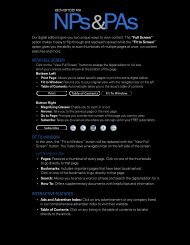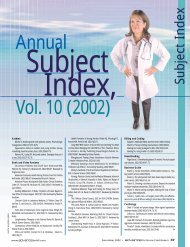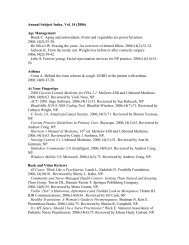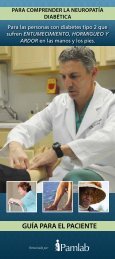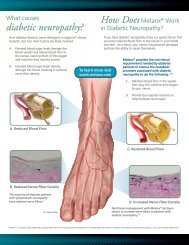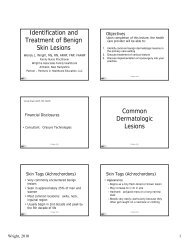View Full Screen - ADVANCE for NPs & PAs
View Full Screen - ADVANCE for NPs & PAs
View Full Screen - ADVANCE for NPs & PAs
Create successful ePaper yourself
Turn your PDF publications into a flip-book with our unique Google optimized e-Paper software.
CME/CE: Neurology<br />
Table 1<br />
Definition of Mild Traumatic Brain Injury 7<br />
A patient with mild traumatic brain injury has experienced a traumatically induced physiologic disruption of brain function, as<br />
manifested by at least one of the following:<br />
1. Any loss of consciousness<br />
2. Any loss of memory about events immediately be<strong>for</strong>e or after the accident<br />
3. Any alteration in mental state at the time of the accident (feeling dazed, confused, seeing stars)<br />
4. Focal neurologic deficits that may or may not be transient but in which the severity of the injury does not exceed the following:<br />
loss of consciousness <strong>for</strong> 30 minutes or less; after 30 minutes, an initial Glasgow Coma Scale score of 13 to 15; posttraumatic<br />
amnesia lasting not more than 24 hours<br />
This definition includes:<br />
1. The head being struck<br />
2. The head striking an object<br />
3. The brain undergoing an acceleration/deceleration movement (i.e., whiplash) without direct external trauma to the head<br />
Developed by the American Congress of Rehabilitation Medicine, http://www.acrm.org/pdf/TBIDef_English_Oct2010.pdf<br />
Blast-related events are the leading<br />
cause of head injury in the military,<br />
followed in order by the other events<br />
mentioned above. 4 As a result of several<br />
factors, the number of concussions<br />
reported is lower than the number of<br />
actual occurrences.<br />
Many patients who experience concussion<br />
and receive medical care do not<br />
have a TBI diagnosis recorded, especially<br />
when multiple injuries are present. 5 In<br />
addition, up to 25% of patients with a<br />
concussion do not seek medical care. 6<br />
Reasons include lack of outward physical<br />
injury, symptom resolution be<strong>for</strong>e<br />
they can seek medical care, and lack of<br />
awareness that they should seek care.<br />
In 2007, the Department of Defense<br />
(DoD) started TBI screening programs<br />
<strong>for</strong> service members who returned from<br />
war zones, in order to identify soldiers<br />
who may have sustained a concussive<br />
event while deployed. Today, screening<br />
is per<strong>for</strong>med on all service members at<br />
the end of deployment or when evacuated<br />
from theater due to injury. Because<br />
so many service members and <strong>for</strong>mer<br />
service members are seen outside the<br />
military healthcare system, providers<br />
in civilian settings should be aware of<br />
the incidence and causes of concussion<br />
in this population.<br />
Mechanisms of Injury<br />
The mechanisms of injury in an mTBI<br />
encompass one or more of the following:<br />
• Direct contact, such as something<br />
hitting the head while the head is at rest,<br />
causing focal damage.<br />
• Acceleration in combination with<br />
deceleration, also known as coup–contrecoup,<br />
in which the brain moves within<br />
the skull. This can cause damage to multiple<br />
areas, depending on how the brain<br />
slides. This can occur in a car accident<br />
that produces a <strong>for</strong>ward and backward<br />
motion of the head, causing the brain<br />
to slide. The frontal and occipital lobes<br />
absorb this impact.<br />
• Rotational <strong>for</strong>ces that cause shearing<br />
of the cerebral white matter axons.<br />
• A blast overpressure wave, followed<br />
by possible further concussive <strong>for</strong>ces, such<br />
as being hit by debris, being thrown or<br />
inhaling fumes.<br />
Diagnostic Criteria<br />
The American Congress of Rehabilitation<br />
Medicine established criteria <strong>for</strong> mTBI 7<br />
(Table 1) in 1993, defining it as a traumatically<br />
induced physiologic disruption of<br />
brain function. The diagnosis of mTBI<br />
does not mean the symptoms are mild;<br />
at times these symptoms can be disabling.<br />
In 1997, the American Academy of<br />
Neurology published a sports concussion<br />
grading system (Table 2). 8<br />
An essential common element in the<br />
two sets of criteria is a traumatic blow or<br />
jolt to the head that causes an inability<br />
<strong>for</strong> the brain to function normally, even<br />
if it is <strong>for</strong> seconds.<br />
In our current state of heightened<br />
awareness of TBI, especially among<br />
military personnel, it is not uncommon<br />
<strong>for</strong> providers and patients to diagnose a<br />
concussion based on symptoms alone.<br />
But if alteration of consciousness (AOC)<br />
or greater has not occurred, a concussion<br />
diagnosis is not appropriate. In addition<br />
to being inaccurate, a symptom-based<br />
diagnosis may delay treatment of the<br />
real diagnosis.<br />
The natural history of a concussion<br />
involves resolution within minutes to<br />
several months. 9-11 In patients older than<br />
40 and in patients with preexisting conditions,<br />
recovery may take longer. 10 When<br />
symptoms last more than 3 months, the<br />
diagnosis of post-concussion syndrome<br />
may apply.<br />
The percentage of patients who have<br />
unrelenting symptoms ranges from 5%<br />
to 15%. 12,13 Influencing factors include<br />
pre-existing conditions, psychiatric conditions,<br />
chronic pain, substance abuse,<br />
secondary gain, unemployment and lack<br />
of support systems. 14<br />
Repetitive Injury<br />
Education about the prevention of repeat<br />
brain injury is vital yet often overlooked.<br />
A patient with a concussion may not be<br />
thinking clearly and may put himself or<br />
herself at risk <strong>for</strong> additional head injuries.<br />
In addition, the patient’s reaction time<br />
may be slowed.<br />
Several studies have documented the<br />
consequences of repeat concussions.<br />
Repetitive brain injury can lead to longer<br />
lasting symptoms, chronic headaches,<br />
slower response time and decreased academic<br />
scores. 15<br />
Recent studies of football players who<br />
sustained multiple concussions identified<br />
changes to brain pathology, known<br />
as chronic traumatic encephalopathy, 16<br />
16 <strong>ADVANCE</strong> <strong>for</strong> NP & <strong>PAs</strong>



